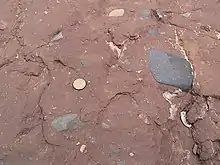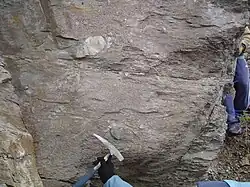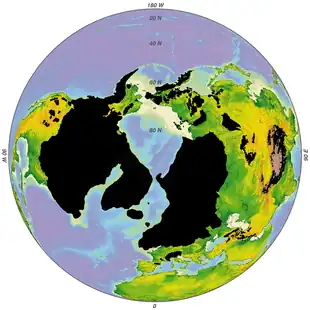Neoproterozoic Snowball Periods | ||||||
−1000 — – −950 — – −900 — – −850 — – −800 — – −750 — – −700 — – −650 — – −600 — – −550 — | Marinoan (millions of years ago) | |||||
| ||||||
A recent estimate of the timing and duration of Proterozoic glacial periods. Note that great uncertainty surrounds the dating of pre-Gaskiers glaciations. The status of the Kaigas is not clear; its dating is very tentative and many researchers do not recognise it as a glaciation.[1] An earlier and longer possible snowball phase, the Huronian glaciation, is not shown here. | ||||||
The Marinoan glaciation, sometimes also known as the Varanger glaciation,[2] was a period of worldwide glaciation.[3] Its beginning is poorly constrained, but occurred no earlier than 654.5 Ma (million years ago).[4] It ended approximately 632.3 ± 5.9 Ma[3] during the Cryogenian period. This glaciation possibly covered the entire planet, in an event called the Snowball Earth. The end of the glaciation was caused by volcanic release of carbon dioxide and dissolution of gas hydrates[5] and might have been hastened by the release of methane from equatorial permafrost.[6][7]
Origin of name and history of terminology
The name is derived from the stratigraphic terminology of the Adelaide Geosyncline (Adelaide Rift Complex) in South Australia and is taken from the Adelaide suburb of Marino. The term Marinoan Series was first used in a 1950 paper by Douglas Mawson and Reg Sprigg to subdivide the Neoproterozoic rocks of the Adelaide area and encompassed all strata from the top of the Brighton Limestone to the base of the Cambrian.[8] The corresponding time period, referred to as the Marinoan Epoch, spanned from the middle Cryogenian to the top of the Ediacaran in modern terminology. Mawson recognised a glacial episode within the Marinoan Epoch which he referred to as the Elatina glaciation after the 'Elatina Tillite' (now Elatina Formation) where he found the evidence.[9] However, the term Marinoan glaciation came into common usage because it was the glaciation that occurred during the Marinoan Epoch, as distinct from the earlier glaciation during the Sturtian Epoch (the time period of deposition of the older Sturtian Series[8]).
The term Marinoan glaciation was later applied globally to any glaciogenic formations assumed (directly or indirectly) to correlate with Mawson's original Elatina glaciation in South Australia.[10] Recently, there has been a move to return to the term Elatina glaciation in South Australia because of uncertainties regarding global correlation and because an Ediacaran glacial episode (Gaskiers) also occurs within the wide-ranging Marinoan Epoch.[11]
Cryogenian Snowball Earth
Emerging evidence suggests that the Earth underwent a number of glaciations during the Neoproterozoic era.[12] There were three (or possibly four) significant ice ages during the late Neoproterozoic. These periods of nearly complete glaciation of Earth are often referred to as "Snowball Earth", where it is hypothesized that at times the planet was covered by ice 1–2 km (0.62–1.24 mi) thick.[13] Of these glaciations, the Sturtian glaciation was the most significant, whereas the Marinoan was a shorter, but still worldwide glaciation. Other Cryogenian glaciations were probably small and not global as compared to the Marinoan or Sturtian glaciations.
During the Marinoan glaciation, characteristic glacial deposits indicate that Earth suffered one of the most severe ice ages in its history. Glaciers extended and contracted in a series of rhythmic pulses, possibly reaching as far as the equator.[14][15]
The Earth may not have been fully covered in ice, as some computer simulations show an extreme slowdown of the hydrological cycle that inhibited new glacial formation before the Earth was fully ice-covered.[16]
The melting of the Snowball Earth is associated with greenhouse warming due to the accumulation of high levels of carbon dioxide in the atmosphere.[17] Deglaciation likely started in the mid-latitudes, as in the tropics, the intense hydrological cycle replenished snow rapidly. As the mid-latitudes became ice free, dust was blown from them into other regions, lowering albedo and speeding up deglaciation.[18]
Evidence


Even though much evidence has been lost through geological changes, field investigations show evidence of the Marinoan glaciation in China, Svalbard archipelago and South Australia. In Guizhou Province, China, glacial rocks were found to be underlying and overlying a layer of volcanic ashes which contained zircon minerals, which could be dated through radioisotopes. Glacial deposits in South Australia are approximately the same age (about 630 Ma), confirmed by similar stable carbon isotopes, mineral deposits (including sedimentary barite), and other unusual sedimentary structures.[13] Two diamictite-rich layers in the top 1 km (0.62 mi) of the 7 km (4.3 mi) Neoproterozoic strata of the northeastern Svalbard archipelago represent the first and final phases of the Marinoan glaciation.[19] In Uruguay, evidence of the Marinoan glaciation is known from dropstones, diamictites, rhythmites, clast layers, and varve-like deposits.[2]
According to Eyles and Young, the Marinoan is a second episode of Neoproterozoic glaciation (680–690 Ma) occurring in the Adelaide Geosyncline. According to them, "It is separated from the Sturtian by a thick succession of sedimentary rocks containing no evidence of glaciation. This glacial phase could correspond to the recently described Ice Brooke formation in the northern Cordillera."[20]
See also
References
- ↑ Smith, A.G. (2009). "Neoproterozoic timescales and stratigraphy". Geological Society, London, Special Publications. 326 (1): 27–54. Bibcode:2009GSLSP.326...27S. doi:10.1144/SP326.2. S2CID 129706604.
- 1 2 Pazos, Pablo J.; Sánchez-Bettucci, Leda; Tofalo, Ofelia R. (January 2003). "The Record of the Varanger Glaciation at the Río De La Plata Craton, Vendian-Cambrian of Uruguay". Gondwana Research. 6 (1): 65–77. Bibcode:2003GondR...6...65P. doi:10.1016/S1342-937X(05)70644-4. Retrieved 16 October 2022.
- 1 2 Rooney, Alan D.; Strauss, Justin V.; Brandon, Alan D.; Macdonald, Francis A. (2015). "A Cryogenian chronology: Two long-lasting synchronous Neoproterozoic glaciations". Geology. 43 (5): 459–462. Bibcode:2015Geo....43..459R. doi:10.1130/G36511.1.
- ↑ Ma, Xiaochen; Wang, Jiasheng; Wang, Zhou; Algeo, Thomas J.; Chen, Can; Cen, Yue; Yin, Qing-Zhu; Huang, Chang; Xu, Liyuan; Huang, Chao; Chen, Dahe (March 2023). "Geochronological constraints on Cryogenian ice ages: Zircon Usingle bondPb ages from a shelf section in South China". Global and Planetary Change. 222. doi:10.1016/j.gloplacha.2023.104071. Retrieved 1 June 2023.
- ↑ Sun, Ruiyang; Shen, Jun; Grasby, Stephen E.; Zhang, Jiawei; Chen, Jianshu; Yang, Chuang; Yin, Runsheng (December 2022). "CO2 buildup drove global warming, the Marinoan deglaciation, and the genesis of the Ediacaran cap carbonates". Precambrian Research. 383: 106891. doi:10.1016/j.precamres.2022.106891. S2CID 253430013. Retrieved 17 December 2022.
- ↑ Shields, G. A. (2008). "Palaeoclimate: Marinoan meltdown". Nature Geoscience. 1 (6): 351–353. Bibcode:2008NatGe...1..351S. doi:10.1038/ngeo214.
- ↑ Kennedy, M.; Mrofka, D.; von Der Borch, C. (2008). "Snowball Earth termination by destabilization of equatorial permafrost methane clathrate". Nature. 453 (7195): 642–5. Bibcode:2008Natur.453..642K. doi:10.1038/nature06961. PMID 18509441. S2CID 4416812.
- 1 2 Mawson, D.; Sprigg, R.C. (1950). "Subdivision of the Adelaide System". Australian Journal of Science. 13: 69–72.
- ↑ Mawson, D. (1949). "A third occurrence of glaciation evidenced in the Adelaide System". Transactions of the Royal Society of South Australia. 73: 117–121.
- ↑ Wen, Bin; Evans, David A. D.; Li, Yong-Xiang; Wang, Zhengrong; Liu, Chao (2015-12-01). "Newly discovered Neoproterozoic diamictite and cap carbonate (DCC) couplet in Tarim Craton, NW China: Stratigraphy, geochemistry, and paleoenvironment". Precambrian Research. 271: 278–294. Bibcode:2015PreR..271..278W. doi:10.1016/j.precamres.2015.10.006.
- ↑ Williams, G.E.; Gostin, V.A.; McKirdy, D.M.; Preiss, W.V. (2008). "The Elatina glaciation, late Cryogenian (Marinoan Epoch), South Australia: Sedimentary facies and palaeoenvironments". Precambrian Research. 163 (3–4): 307–331. Bibcode:2008PreR..163..307W. doi:10.1016/j.precamres.2007.12.001.
- ↑ Allen, Philip A.; Etienne, James L. (2008). "Sedimentary challenge to Snowball Earth". Nature Geoscience. 1 (12): 817–825. Bibcode:2008NatGe...1..817A. doi:10.1038/ngeo355.
- 1 2 "New Evidence Supports Three Major Glaciation Events In The Distant Past". ScienceDaily. 2004-04-22. Retrieved 2011-06-18.
- ↑ Dave Lawrence (2003). "Microfossil lineages support sloshy snowball Earth". Geotimes. Retrieved 2011-06-18.
- ↑ "Global Glaciation Snowballed Into Giant Change in Carbon Cycle". ScienceDaily. 2010-05-02. Retrieved 2011-06-18.
- ↑ Chandler, Mark A.; Sohl, Linda E. (1 August 2000). "Climate forcings and the initiation of low-latitude ice sheets during the Neoproterozoic Varanger glacial interval". Journal of Geophysical Research. 105 (D16): 20737–20756. doi:10.1029/2000JD900221. Retrieved 9 May 2023.
- ↑ Pierrehumbert, R.T. (2004). "High levels of atmospheric carbon dioxide necessary for the termination of global glaciation". Nature. 429 (6992): 646–9. Bibcode:2004Natur.429..646P. doi:10.1038/nature02640. PMID 15190348. S2CID 2205883.
- ↑ De Vrese, Philipp; Stacke, Tobias; Rugenstein, Jeremy Caves; Goodman, Jason; Brovkin, Victor (14 May 2021). "Snowfall-albedo feedbacks could have led to deglaciation of snowball Earth starting from mid-latitudes". Communications Earth & Environment. 2 (1): 1–9. doi:10.1038/s43247-021-00160-4. Retrieved 9 May 2023.
- ↑ Halverson GP, Maloof AC, Hoffman PF (2004). "The Marinoan glaciation (Neoproterozoic) in northeast Svalbard" (PDF). Basin Research. 16 (3): 297–324. Bibcode:2004BasR...16..297H. CiteSeerX 10.1.1.368.2815. doi:10.1111/j.1365-2117.2004.00234.x. S2CID 53588955. Archived from the original (PDF) on 2012-03-20. Retrieved 2011-06-18.
- ↑ Eyles, Nicholas; Young, Grant (1994). Deynoux, M.; Miller, J.M.G.; Domack, E.W.; Eyles, N.; Fairchild, I.J.; Young, G.M. (eds.). Geodynamic controls on glaciation in Earth history, in Earth's Glacial Record. Cambridge: Cambridge University Press. pp. 5–10. ISBN 978-0521548038.
